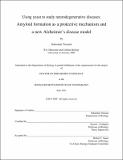| dc.contributor.advisor | Susan L. Lindquist. | en_US |
| dc.contributor.author | Treusch, Sebastian | en_US |
| dc.contributor.other | Massachusetts Institute of Technology. Dept. of Biology. | en_US |
| dc.date.accessioned | 2011-08-16T15:25:39Z | |
| dc.date.available | 2011-08-16T15:25:39Z | |
| dc.date.copyright | 2011 | en_US |
| dc.date.issued | 2011 | en_US |
| dc.identifier.uri | http://hdl.handle.net/1721.1/65175 | |
| dc.description | Thesis (Ph. D.)--Massachusetts Institute of Technology, Dept. of Biology, 2011. | en_US |
| dc.description | This electronic version was submitted by the student author. The certified thesis is available in the Institute Archives and Special Collections. | en_US |
| dc.description | Cataloged from student submitted PDF version of thesis. | en_US |
| dc.description | Includes bibliographical references. | en_US |
| dc.description.abstract | Numerous neurodegenerative diseases are pathologically characterized by idiosyncratic protein amyloid inclusions. Not surprisingly amyloid fibrils have long been proposed to be the toxic protein species in these neurodegenerative diseases. However, more recent work has begun to suggest that the formation of ordered inclusions serves a protective role and that soluble oligomers on pathway to amyloid formation cause neuronal death. In that regard, ordered protein inclusions, such as aggresomes, have also been shown to facilitate the asymmetric inheritance of protein damage during the mitoses of cells ranging from E. coli to human stem cells. Yeast prion proteins are another group of proteins capable of adapting an amyloid conformation. The self-templating amyloid fold allows yeast prions to act as non-Mendelian elements of inheritance. We have shown that yeast prion amyloid fibrils, especially upon prion protein overexpression, localize to the IPOD (insoluble protein deposit), an ordered inclusion proximal to the vacuole, and that the majority of the prion amyloid is asymmetrically inherited upon cell division. I used the yeast prion Rnq1 to investigate how amyloid formation contributes to proteotoxicity. Ectopic overexpression of Rnq1 was extremely toxic, but only if the endogenous Rnq1 protein had adopted its amyloid conformation. The Hsp40 co-chaperone Sis1 was able to counteract the Rnq1-induced toxicity when co-overexpressed. In collaboration with Doug Cyr's lab I showed that Sis1-mediated amyloid formation was cytoprotective and that disordered non-amyloid aggregates induced toxicity. These results provide evidence that the formation of ordered inclusions can be cytoprotective. I further characterized Rnq1 toxicity, conducted two genome-ide screens for modifiers and found that Rnq1 induced a G2/M cell cycle arrest. Rnq1 overexpression resulted in the mislocalization of the core spindle pole body component Spc42 to the IPOD and an unduplicated spindle pole body. In mammalian cells aggresomes localize to centrosomes, the mammalian equivalent of the yeast spindle pole body. The finding that a yeast prion can interact with a spindle pole body component represents a new connection between the IPOD and aggresomes. Lastly, I studied a yeast model of A[beta] 1-42 toxicity. Accumulation of the amyloid beta peptide is thought to be causal in both sporadic and familial Alzheimer's disease. In collaboration with Kent Matlack I developed a yeast model that expressed A[beta] 1-42 in a manner recapitulating mammalian A[beta] 1-42 generation and that was amenable to screens for genetic modifiers of A[beta] 1-42 toxicity. The screen identified the yeast homolog of PICALM, a known Alzheimer's disease risk factor. I showed that A[beta] 1-42 expression resulted in a defect in endocytosis that could be reverted by several of the genetic suppressors. In collaboration with the Caldwell lab, we showed that the genetic modifiers also modulated A[beta] 1-42 toxicity in a neuronal setting, C. elegans glutamatergic neurons. Finally, we showed that PICALM could protect primary rat cortical neuron cultures from A[beta] oligomer toxicity. | en_US |
| dc.description.statementofresponsibility | by Sebastian Treusch. | en_US |
| dc.format.extent | 277 p. | en_US |
| dc.language.iso | eng | en_US |
| dc.publisher | Massachusetts Institute of Technology | en_US |
| dc.rights | M.I.T. theses are protected by
copyright. They may be viewed from this source for any purpose, but
reproduction or distribution in any format is prohibited without written
permission. See provided URL for inquiries about permission. | en_US |
| dc.rights.uri | http://dspace.mit.edu/handle/1721.1/7582 | en_US |
| dc.subject | Biology. | en_US |
| dc.title | Using yeast to study neurodegenerative diseases : amyloid formation as a protective mechanism and a new Alzheimer's disease model | en_US |
| dc.title.alternative | Amyloid formation as a protective mechanism and a new Alzheimer's disease model | en_US |
| dc.type | Thesis | en_US |
| dc.description.degree | Ph.D. | en_US |
| dc.contributor.department | Massachusetts Institute of Technology. Department of Biology | |
| dc.identifier.oclc | 745458414 | en_US |
